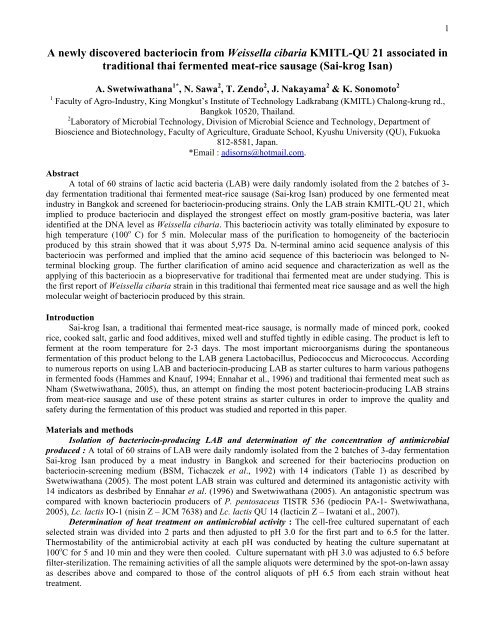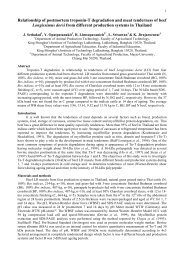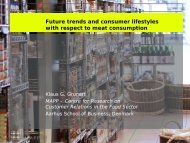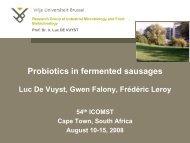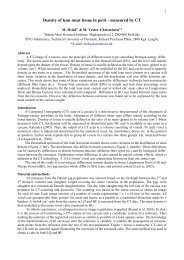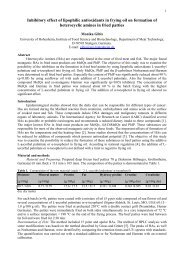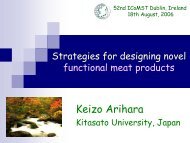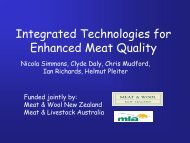A newly discovered bacteriocin from Weissella cibaria KMITL-QU 21
A newly discovered bacteriocin from Weissella cibaria KMITL-QU 21
A newly discovered bacteriocin from Weissella cibaria KMITL-QU 21
You also want an ePaper? Increase the reach of your titles
YUMPU automatically turns print PDFs into web optimized ePapers that Google loves.
A <strong>newly</strong> <strong>discovered</strong> <strong>bacteriocin</strong> <strong>from</strong> <strong>Weissella</strong> <strong>cibaria</strong> <strong>KMITL</strong>-<strong>QU</strong> <strong>21</strong> associated in<br />
traditional thai fermented meat-rice sausage (Sai-krog Isan)<br />
A. Swetwiwathana 1* , N. Sawa 2 , T. Zendo 2 , J. Nakayama 2 & K. Sonomoto 2<br />
1 Faculty of Agro-Industry, King Mongkut’s Institute of Technology Ladkrabang (<strong>KMITL</strong>) Chalong-krung rd.,<br />
Bangkok 10520, Thailand.<br />
2 Laboratory of Microbial Technology, Division of Microbial Science and Technology, Department of<br />
Bioscience and Biotechnology, Faculty of Agriculture, Graduate School, Kyushu University (<strong>QU</strong>), Fukuoka<br />
812-8581, Japan.<br />
*Email : adisorns@hotmail.com.<br />
Abstract<br />
A total of 60 strains of lactic acid bacteria (LAB) were daily randomly isolated <strong>from</strong> the 2 batches of 3-<br />
day fermentation traditional thai fermented meat-rice sausage (Sai-krog Isan) produced by one fermented meat<br />
industry in Bangkok and screened for <strong>bacteriocin</strong>-producing strains. Only the LAB strain <strong>KMITL</strong>-<strong>QU</strong> <strong>21</strong>, which<br />
implied to produce <strong>bacteriocin</strong> and displayed the strongest effect on mostly gram-positive bacteria, was later<br />
identified at the DNA level as <strong>Weissella</strong> <strong>cibaria</strong>. This <strong>bacteriocin</strong> activity was totally eliminated by exposure to<br />
high temperature (100 o C) for 5 min. Molecular mass of the purification to homogeneity of the <strong>bacteriocin</strong><br />
produced by this strain showed that it was about 5,975 Da. N-terminal amino acid sequence analysis of this<br />
<strong>bacteriocin</strong> was performed and implied that the amino acid sequence of this <strong>bacteriocin</strong> was belonged to N-<br />
terminal blocking group. The further clarification of amino acid sequence and characterization as well as the<br />
applying of this <strong>bacteriocin</strong> as a biopreservative for traditional thai fermented meat are under studying. This is<br />
the first report of <strong>Weissella</strong> <strong>cibaria</strong> strain in this traditional thai fermented meat rice sausage and as well the high<br />
molecular weight of <strong>bacteriocin</strong> produced by this strain.<br />
Introduction<br />
Sai-krog Isan, a traditional thai fermented meat-rice sausage, is normally made of minced pork, cooked<br />
rice, cooked salt, garlic and food additives, mixed well and stuffed tightly in edible casing. The product is left to<br />
ferment at the room temperature for 2-3 days. The most important microorganisms during the spontaneous<br />
fermentation of this product belong to the LAB genera Lactobacillus, Pediococcus and Micrococcus. According<br />
to numerous reports on using LAB and <strong>bacteriocin</strong>-producing LAB as starter cultures to harm various pathogens<br />
in fermented foods (Hammes and Knauf, 1994; Ennahar et al., 1996) and traditional thai fermented meat such as<br />
Nham (Swetwiwathana, 2005), thus, an attempt on finding the most potent <strong>bacteriocin</strong>-producing LAB strains<br />
<strong>from</strong> meat-rice sausage and use of these potent strains as starter cultures in order to improve the quality and<br />
safety during the fermentation of this product was studied and reported in this paper.<br />
Materials and methods<br />
Isolation of <strong>bacteriocin</strong>-producing LAB and determination of the concentration of antimicrobial<br />
produced : A total of 60 strains of LAB were daily randomly isolated <strong>from</strong> the 2 batches of 3-day fermentation<br />
Sai-krog Isan produced by a meat industry in Bangkok and screened for their <strong>bacteriocin</strong>s production on<br />
<strong>bacteriocin</strong>-screening medium (BSM, Tichaczek et al., 1992) with 14 indicators (Table 1) as described by<br />
Swetwiwathana (2005). The most potent LAB strain was cultured and determined its antagonistic activity with<br />
14 indicators as desbribed by Ennahar et al. (1996) and Swetwiwathana (2005). An antagonistic spectrum was<br />
compared with known <strong>bacteriocin</strong> producers of P. pentosaceus TISTR 536 (pediocin PA-1- Swetwiwathana,<br />
2005), Lc. lactis IO-1 (nisin Z – JCM 7638) and Lc. lactis <strong>QU</strong> 14 (lacticin Z – Iwatani et al., 2007).<br />
Determination of heat treatment on antimicrobial activity : The cell-free cultured supernatant of each<br />
selected strain was divided into 2 parts and then adjusted to pH 3.0 for the first part and to 6.5 for the latter.<br />
Thermostability of the antimicrobial activity at each pH was conducted by heating the culture supernatant at<br />
100 o C for 5 and 10 min and they were then cooled. Culture supernatant with pH 3.0 was adjusted to 6.5 before<br />
filter-sterilization. The remaining activities of all the sample aliquots were determined by the spot-on-lawn assay<br />
as describes above and compared to those of the control aliquots of pH 6.5 <strong>from</strong> each strain without heat<br />
treatment.<br />
1
Identification of <strong>bacteriocin</strong>-producing strains by using 16S rDNA : DNA extraction and PCR analysis<br />
were performed as described by Zendo et al. (2005). Primers using for 16S rDNA sequence were primer 8UA<br />
(5’- AGAGTTTGATCCTGGCTCAG –3’) and 1510B (5’- GTGAAGCTTACG GCTACCTTGTTACGACTT –<br />
3’) based on primers described by Martinez-Murcia et al. (1995). Purified PCR product was used for DNA<br />
sequencing (Macrogen, Seoul, Korea). The obtained DNA sequences were analyzed using GENETYX-WIN<br />
software (GENETYX, Tokyo, Japan). Database searches were performed using BLAST of the National Center<br />
for Biotechnology Information (NCBI, http://www.ncbi.nlm.nih.gov/BLAST/).<br />
Bacteriocins purification, mass spectrometric and amino acid sequences: The cell-free supernatant of 1<br />
liters culture incubated at 30 o C of M 13-5 was purified by a four step procedures as described by Ennahar et al.<br />
(1996). The final sample containing the purified <strong>bacteriocin</strong>s was dried by Speed-Vac rotary evaporator (Savant<br />
Instruments) and stored at –20 o C for molecular mass determination. The molecular masses of purified<br />
<strong>bacteriocin</strong>s were determined using a Accu TOF spectrometer, model JMS-T100LC (Agilent Technologies,<br />
Germany).<br />
Results and discussions<br />
<strong>KMITL</strong>-<strong>QU</strong> <strong>21</strong>, was the only strain of 60 isolated LAB <strong>from</strong> Sai-krog Isan, that implied to exhibit an<br />
inhibition activities against the tested indicators on <strong>bacteriocin</strong>-screening medium (data not shown). When<br />
compared its antagonistic activity <strong>from</strong> MRS cultured cell-free supernatant of <strong>KMITL</strong>-<strong>QU</strong> <strong>21</strong> with 3 known<br />
<strong>bacteriocin</strong>s of pediocin PA-1, nisin Z and lacticin Z (Table 1), it was revealed that antagonistic spectrum of<br />
<strong>KMITL</strong>-<strong>QU</strong> <strong>21</strong> cell-free supernatant exhibited different spectrum <strong>from</strong> these 3 known <strong>bacteriocin</strong>s. Its<br />
antagonistic produced exhibited an inhibitory effect to nisin Z producer strain of Lc. lactis IO-1. Moreover, the<br />
<strong>KMITL</strong>-<strong>QU</strong> <strong>21</strong> strain was sensitive to lacticin Z and nisin Z which produced <strong>from</strong> Lc. lactis <strong>QU</strong> 14 and IO-1,<br />
respectively. Antimicrobial activities of the produced <strong>from</strong> <strong>KMITL</strong>-<strong>QU</strong> <strong>21</strong> was completely affected by heating<br />
at 100 o C for 5 min at pH 6.5 and 10 min at pH 3.0 (Table 2), while all known <strong>bacteriocin</strong>s were partially affected<br />
by the same time and temperature at both studied pH. By the partial DNA sequence analysis (about 1,500 base<br />
pairs) for strain identification (data not shown), the results showed the 99% of identity related to Weisella<br />
<strong>cibaria</strong>.<br />
Table 1. Antimicrobial spectrum of <strong>bacteriocin</strong> like substance (AU/ml) <strong>from</strong> <strong>KMITL</strong>-<strong>QU</strong> <strong>21</strong> compared to other<br />
known <strong>bacteriocin</strong>s<br />
Indicator TISTR536 <strong>QU</strong> 14 <strong>KMITL</strong>-<strong>QU</strong> <strong>21</strong> IO-1<br />
Pediococcus dextrinicus NT 25,600 400 NT<br />
P. pentosaceus JCM 5885 200 200 200 1,600<br />
Lb. plantarum ATCC 14917 T 6,400 800 0 1,600<br />
Lb. sakei subsp. sakei JCM 1157 T 6,400 3,200 6,400 25,600<br />
Lc. lactis subsp. lactis ATCC 19435 T 0 12,800 200 1,600<br />
Leuconostoc mesenteroides JCM 6124 T 800 100 400 1,600<br />
Micrococcus luteus IFO 12708 0 100 100 800<br />
Listeria innocua ATCC 33090 T 3,200 200 0 800<br />
Enterococcus faecalis JCM 5803 T 800 800 0 400<br />
Ent. faecium TUA 1344L 6,400 800 0 1,600<br />
Bacillus circulans JCM 2504 T 0 200 100 6,400<br />
B. coagulans JCM 2257 T 0 12,800 1,600 6,400<br />
B subtilis JCM 1465 T 0 100 0 1,600<br />
Escherichia coli JM 109 0 0 0 0<br />
TISTR536 (produced pediocin PA-1) 0 0 0 0<br />
<strong>QU</strong> 14 (produced lacticin Z) 0 0 0 400<br />
<strong>KMITL</strong>-<strong>QU</strong> <strong>21</strong> 0 400 0 400<br />
IO-1 (produced nisin Z) JCM 7638 0 400 400 0<br />
ATCC, American Type Culture Collection, Rockville, Md; JCM, Japanese Culture of Microorganisms, Japan; JM,<br />
commercial strain <strong>from</strong> Toyobo, Osaka, Japan; TUA, Tokyu University of Agriculture, Japan; TISTR 536, P. pentosaceuspediocin<br />
PA-1 producer; IO-1, Lc. lactis- nisin Z producer.<br />
The antagonistic substances produced by <strong>KMITL</strong>-<strong>QU</strong> <strong>21</strong> was later purified and determined for the<br />
molecular weight (MW) (Fig. 1), it was found that MW of the purified fraction was about 5,975 d (Fig. 2) which<br />
2
elated to lactizin Z (MW = 5,968.9 d) produced <strong>from</strong> Lactococcus lactis <strong>QU</strong>14 (Iwatani et al., 2007). This<br />
molecular weight of <strong>bacteriocin</strong> had never been reported to produce by W. <strong>cibaria</strong>, hence, we realized that this<br />
<strong>bacteriocin</strong> <strong>from</strong> W. <strong>cibaria</strong> <strong>KMITL</strong>-<strong>QU</strong> <strong>21</strong> might be a novel <strong>bacteriocin</strong>. This <strong>bacteriocin</strong> is under further<br />
studying for some characterizations and amino acid sequence determination.<br />
Table 2. Sensitivity of the antimicrobial compounds produced by <strong>KMITL</strong>-<strong>QU</strong> <strong>21</strong>to heat treatments<br />
Residual activity (AU/ml)<br />
Strain Control pH 6.5 pH 3.0<br />
100 o C, 5 min 100 o C, 10 min 100 o C, 5 min 100 o C, 10 min<br />
<strong>KMITL</strong>-<strong>QU</strong> <strong>21</strong> 6,400 0 0 100 0<br />
TISTR 536 6,400 3,200 1,600 6,400 3,200<br />
IO-1 25,600 6,400 1,600 12,800 12,800<br />
<strong>QU</strong> 14 3,200 800 0 1,600 400<br />
L. sakei subsp. sakei JCM 1157 T was used as an indicator strain for the remaining activity<br />
3<br />
Purified active fraction of<br />
<strong>bacteriocin</strong>-like<br />
1195.1 x 5 = 5975.5 d<br />
1494.2 x 4 = 5976.8 d<br />
1991.6 x 3 = 5974.8 d<br />
2987.5 x 2 = 5975.0 d<br />
Figure 1. Reverse Phase HPLC profiles of <strong>bacteriocin</strong>-like Figure 2. Molecualr mass of purified <strong>bacteriocin</strong> fraction<br />
produced <strong>from</strong> W. <strong>cibaria</strong> <strong>KMITL</strong>-<strong>QU</strong> <strong>21</strong>. <strong>from</strong> W. <strong>cibaria</strong> <strong>KMITL</strong>-<strong>QU</strong> <strong>21</strong>.<br />
Acknowledgements<br />
We would like to acknowledge the Japan Society for the Promotion of Science (JSPS) and the National<br />
Research Council of Thailand (NRCT) in funding this research work. We also acknowledge Suddhiluck<br />
Innofood Co., LTD. For traditional Thai fermented meat samples supported.<br />
References<br />
Ennahar, S., Aoude-Werner, D., Sorokine, O., Van Dorsselaer, A., Bringel, F., Hubert, J-C. & Hasselmann,<br />
C.1996. Production of pediocin AcH by Lactobacillus plantarum WHE 92 isolated <strong>from</strong> cheese. Appl.<br />
Environ. Microbiol. 62(12):4381–4387.<br />
Hammes, W. P. & Knauf, H. J. 1994. Starters in the processing of meat products. Meat Sci. 36 : 155-168.<br />
Iwatani, S., Zendo, T., Yoneyama, F., Nakayama, J. & Sonomoto, K. 2007. Characterization and structure<br />
analysis of a novel <strong>bacteriocin</strong>, lacticin Z, produced by Lactococcus lactis <strong>QU</strong> 14. Biosci. Biotechnol.<br />
Biochem. 71(8) : 1984-1992.<br />
Martínez-Murcia, A.J., Acinas, S.G. & Rodriguez-Valera, F. 1995. Evaluation of prokaryotic diversity by<br />
restrictase digestion of 16S rDNA directly amplified <strong>from</strong> hypersaline environments. FEMS Microbiol.<br />
Ecology. 17(4):247-255.<br />
Swetwiwathana, A. 2005. Microbiological quality enhancement of Thai fermented meat product (Nham) using<br />
Nham-associated pediocin-producing lactic acid bacteria (Pediococcus pentosaceus TISTR 536). Ph.D.<br />
Thesis of Department of Bioscience and Biotechnology, Kyushu Univ., Japan.<br />
Tichaczek, P. S., Nissen-Meyer, J., Nes, I. F., Vogel, R. F. & Hammes., W. P. 1992. Characterization of the<br />
Bacteriocins Curvacin A <strong>from</strong> Lactobacillus curvatus LTH 1174 and Sakacin P <strong>from</strong> L. sake LTH 673.<br />
System. Appl. Microbiol. 15 : 460 - 468.<br />
Zendo, T., Eungruttanagorn, N., Fujioka, S., Tashiro, Y.,Nomura, K., Sera, Y., Kobayashi, G., Nakayama, J.,<br />
Ishizaki, A. & Sonomoto, K. 2005. Identification and production of a <strong>bacteriocin</strong> <strong>from</strong> Enterococcus<br />
mundtii <strong>QU</strong> 2 isolated <strong>from</strong> soybean. J. Appl. Microbiol. 99 : 1181-1190.<br />
µ


